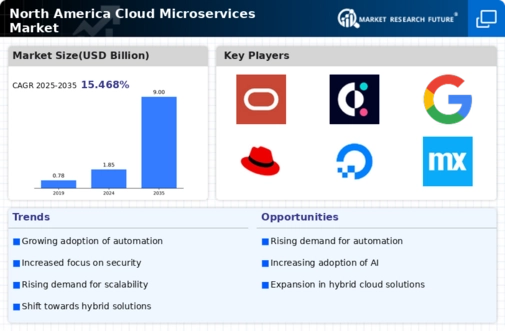The cloud microservices market in North America is characterized by intense competition and rapid innovation, driven by the increasing demand for scalable and flexible IT solutions. Major players such as Amazon Web Services (US), Microsoft (US), and Google Cloud (US) dominate the landscape, each employing distinct strategies to enhance their market presence. Amazon Web Services (US) focuses on continuous innovation and expanding its service offerings, while Microsoft (US) emphasizes strategic partnerships and integration of AI capabilities into its cloud solutions. Google Cloud (US) is leveraging its strengths in data analytics and machine learning to attract enterprise clients, thereby shaping a competitive environment that prioritizes technological advancement and customer-centric solutions.
The market structure appears moderately fragmented, with a mix of established giants and emerging players. Key business tactics include localizing services to meet regional demands and optimizing supply chains to enhance service delivery. The collective influence of these major companies fosters a dynamic ecosystem where agility and responsiveness to market needs are paramount. This competitive structure encourages ongoing investment in research and development, as companies strive to differentiate themselves through innovative offerings and superior customer experiences.
In October 2025, Amazon Web Services (US) announced the launch of its new microservices framework designed to streamline application development for enterprises. This strategic move is likely to enhance AWS's competitive edge by providing developers with more efficient tools, thereby accelerating the adoption of microservices architecture among businesses. Such innovations not only solidify AWS's leadership position but also reflect a broader trend towards simplifying complex cloud environments.
In September 2025, Microsoft (US) expanded its partnership with a leading AI firm to integrate advanced machine learning capabilities into its Azure platform. This collaboration is expected to enhance Azure's functionality, making it more appealing to businesses seeking to leverage AI for operational efficiency. By aligning with AI advancements, Microsoft positions itself as a forward-thinking provider, likely attracting a diverse clientele looking to innovate.
In August 2025, Google Cloud (US) unveiled a new suite of tools aimed at enhancing data security and compliance for its microservices offerings. This initiative underscores Google Cloud's commitment to addressing growing concerns around data privacy and regulatory compliance, which are increasingly critical for enterprises. By prioritizing security, Google Cloud not only meets market demands but also differentiates itself in a crowded field, potentially increasing its market share.
As of November 2025, current trends in the cloud microservices market include a strong emphasis on digitalization, sustainability, and the integration of AI technologies. Strategic alliances are becoming increasingly vital, as companies recognize the need to collaborate to enhance their service offerings and address complex customer needs. Looking ahead, competitive differentiation is likely to evolve from traditional price-based strategies to a focus on innovation, technological advancements, and supply chain reliability. This shift suggests that companies that prioritize these elements will be better positioned to thrive in an increasingly competitive landscape.

















Leave a Comment